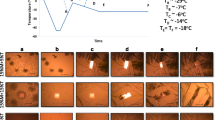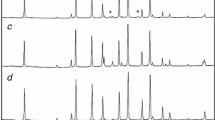ABSTRACT
Purpose
(i) To study the crystallization of trehalose in frozen solutions and (ii) to understand the phase transitions during the entire freeze-drying cycle.
Method
Aqueous trehalose solution was cooled to −40°C in a custom-designed sample holder. The frozen solution was warmed to −18°C and annealed, and then dried in the sample chamber of the diffractometer. XRD patterns were continuously collected during cooling, annealing and drying.
Results
After cooling, hexagonal ice was the only crystalline phase observed. However, upon annealing, crystallization of trehalose dihydrate was evident. Seeding the frozen solution accelerated the solute crystallization. Thus, phase separation of the lyoprotectant was observed in frozen solutions. During drying, dehydration of trehalose dihydrate yielded a substantially amorphous anhydrous trehalose.
Conclusions
Crystallization of trehalose, as trehalose dihydrate, was observed in frozen solutions. The dehydration of the crystalline trehalose dihydrate to substantially amorphous anhydrate occurred during drying. Therefore, analyzing the final lyophile will not reveal crystallization of the lyoprotectant during freeze-drying. The lyoprotectant crystallization can only become evident by continuous monitoring of the system during the entire freeze-drying cycle. In light of the phase separation of trehalose in frozen solutions, its ability to serve as a lyoprotectant warrants further investigation.









Similar content being viewed by others
REFERENCES
Pikal MJ. Freeze drying. In: Swarbrick J, editor. Encyclopedia of pharmaceutical technology, vol. 1. New York: Informa healthcare; 2007. p. 1807–33.
Anhorn MG, Mahler H-C, Langer K. Freeze drying of human serum albumin (HSA) nanoparticles with different excipients. Int J Pharm. 2008;363:162–9.
Imamura K, Asano Y, Maruyama Y, Yokoyama T, Nomura M, Ogawa S, et al. Characteristics of hydrogen bond formation between sugar and polymer in freeze-dried mixtures under different rehumidification conditions and its impact on the glass transition temperature. J Pharm Sci. 2008;97:1301–12.
Izutsu K, Yoshioka S, Takeda Y. The effects of additives on the stability of freeze-dried beta -galactosidase stored at elevated temperature. Int J Pharm. 1991;71:137–46.
Izutsu K, Yoshioka S, Terao T. Decreased protein-stabilizing effects of cryoprotectants due to crystallization. Pharm Res. 1993;10:1232–7.
Randolph TW. Phase separation of excipients during lyophilization: effects on protein stability. J Pharm Sci. 1997;86:1198–203.
Carpenter JF, Pikal MJ, Chang BS, Randolph TW. Rational design of stable lyophilized protein formulations: some practical advice. Pharm Res. 1997;14:969–75.
Chatterjee K, Shalaev EY, Suryanarayanan R. Raffinose crystallization during freeze-drying and its impact on recovery of protein activity. Pharm Res. 2005;22:303–9.
Coutinho C, Bernardes E, Felix D, Panek AD. Trehalose as cryoprotectant for preservation of yeast strains. J Biotechnol. 1988;7:23–32.
Crowe JH, Carpenter JF, Crowe LM. The role of vitrification in anhydrobiosis. Annu Rev Physiol. 1998;60:73–103.
Crowe LM, Reid DS, Crowe JH. Is trehalose special for preserving dry biomaterials? Biophys J. 1996;71:2087–93.
Lu X, Pikal MJ. Freeze-drying of mannitol-trehalose-sodium chloride-based formulations: The impact of annealing on dry layer resistance to mass transfer and cake structure. Pharm Dev Technol. 2004;9:85–95.
Akers MJ. Excipient—drug interactions in parenteral formulations. J Pharm Sci. 2002;91:2283–300.
Surana R, Pyne A, Suryanarayanan R. Effect of aging on the physical properties of amorphous trehalose. Pharm Res. 2004;21:867–74.
Surana R, Pyne A, Suryanarayanan R. Effect of preparation method on physical properties of amorphous trehalose. Pharm Res. 2004;21:1167–76.
Miller DP, De Pablo JJ. Calorimetric solution properties of simple saccharides and their significance for the stabilization of biological structure and function. J Phys Chem B. 2000;104:8876–83.
Bubnik Z, Kadlec P. Sucrose solubility. In: Mathlouthi M, Reiser P, editors. Sucrose properties and applications. Glasgow: Blackie Academic & Processional; 1995. p. 101–25.
Miller DP, De Pablo JJ, Corti H. Thermophysical properties of trehalose and its concentrated aqueous solutions. Pharm Res. 1997;14:578–90.
Green JL, Angell CA. Phase relations and vitrification in saccharide-water solutions and the trehalose anomaly. J Phys Chem. 1989;93:2880–2.
Nicolajsen H, Hvidt A. Phase behavior of the system trehalose-NaCl-water. Cryobiology. 1994;31:199–205.
Sundaramurthi P, Suryanarayanan R. Trehalose crystallization during freeze-drying: Implications on lyoprotection. J Phys Chem Lett. 2010;1:510–4.
Akers MJ, Vasudevan V, Stickelmeyer M. Formulation development of protein dosage forms. Pharm Biotechnol. 2002;14:47–127.
Han J, Suryanarayanan R. Influence of environmental conditions on the kinetics and mechanism of dehydration of carbamazepine dihydrate. Pharm Dev Technol. 1998;3:587–96.
Han J, Suryanarayanan R. A method for the rapid evaluation of the physical stability of pharmaceutical hydrates. Thermochim Acta. 1999;329:163–70.
Allison SD, Chang B, Randolph TW, Carpenter JF. Hydrogen bonding between sugar and protein is responsible for inhibition of dehydration-induced protein unfolding. Arch Biochem Biophys. 1999;365:289–98.
Sundaramurthi P, Shalaev E, Suryanarayanan R. “pH swing” in frozen solutions-consequence of sequential crystallization of buffer components. J Phys Chem Lett. 2010;1:265–8.
Sundaramurthi P, Shalaev E, Suryanarayanan R. Calorimetric and diffractometric evidence for the sequential crystallization of buffer components and consequent pH swing in frozen solutions. J Phys Chem B. 2010;114:4915–23.
Moore TW. Dissolution testing: a fast, efficient procedure for degassing dissolution medium. Dissolution Technol. 1996;3:3–5.
Powder Diffraction File. Hexagonal ice, card # 00-042-1142; D-trehalose dihydrate, card # 00-029-1955; trehalose anhydrate, card # 00-003-0312. International Centre for Diffraction Data, Newtown Square, PA (2004).
Varshney DB, Kumar S, Shalaev EY, Sundaramurthi P, Kang S-W, Gatlin LA, et al. Glycine crystallization in frozen and freeze-dried systems: effect of pH pH and buffer concentration. Pharm Res. 2007;24:593–604.
Pyne A, Chatterjee K, Suryanarayanan R. Crystalline to amorphous transition of disodium hydrogen phosphate during primary drying. Pharm Res. 2003;20:802–3.
Sundaramurthi P, Suryanarayanan R. Influence of crystallizing and non-crystallizing cosolutes on trehalose crystallization during freeze-drying. Pharm Res. 2010; doi:10.1007/s11095-010-0221-8.
Author information
Authors and Affiliations
Corresponding author
Rights and permissions
About this article
Cite this article
Sundaramurthi, P., Patapoff, T.W. & Suryanarayanan, R. Crystallization of Trehalose in Frozen Solutions and its Phase Behavior during Drying. Pharm Res 27, 2374–2383 (2010). https://doi.org/10.1007/s11095-010-0243-2
Received:
Accepted:
Published:
Issue Date:
DOI: https://doi.org/10.1007/s11095-010-0243-2




